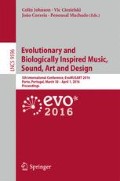Abstract
An algorithmic compositional system that uses hill climbing to create short melodies is presented. A context free grammar maps each section of the resultant individual to a musical segment resulting in a series of MIDI notes described by pitch and duration. The dissimilarity between each pair of segments is measured using a metric based on the pitch contour of the segments. Using a GUI, the user decides how many segments to include and how they are to be distanced from each other. The system performs a hill-climbing search using several mutation operators to create a population of segments the desired distances from each other. A number of melodies composed by the system are presented that demonstrate the algorithm’s ability to match the desired targets and the versatility created by the inclusion of the designed grammar.
Access this chapter
Tax calculation will be finalised at checkout
Purchases are for personal use only
Notes
- 1.
Note that the NC methods use less as each Copy in each of the 1,000 generations requires one evaluation.
References
Biles, J.A.: Straight-ahead jazz with GenJam: a quick demonstration. In: MUME 2013 Workshop (2013)
Brabazon, A., O’Neill, M., McGarraghy, S.: Grammatical evolution. In: Brabazon, A., O’Neill, M., McGarraghy, S. (eds.) Natural Computing Algorithms, pp. 357–373. Springer, Heidelberg (2015)
Chen, A.L., Chang, M., Chen, J., Hsu, J.L., Hsu, C.H., Hua, S.: Query by music segments: an efficient approach for song retrieval. In: ICME 2000, vol. 2, pp. 873–876. IEEE (2000)
Dahlstedt, P.: Autonomous evolution of complete piano pieces and performances. In: Proceedings of Music AL Workshop. Citeseer (2007)
Donnelly, P., Sheppard, J.: Evolving four-part harmony using genetic algorithms. In: Di Chio, C., et al. (eds.) EvoApplications 2011, Part II. LNCS, vol. 6625, pp. 273–282. Springer, Heidelberg (2011)
Fernández, J.D., Vico, F.: AI methods in algorithmic composition: a comprehensive survey. J. Artif. Intell. Res. 48, 513–582 (2013)
Hargreaves, D.J.: The effects of repetition on liking for music. J. Res. Music Educ. 32(1), 35–47 (1984)
Hu, N., Dannenberg, R.B., Lewis, A.L.: A probabilistic model of melodic similarity. In: International Computer Music Conference (ICMC), Goteborg, Sweden. International Computer Music Society (2002)
Lemström, K., Ukkonen, E.: Including interval encoding into edit distance based music comparison and retrieval. In: Proceedings of the AISB, pp. 53–60 (2000)
Logan, B., Salomon, A.: A music similarity function based on signal analysis. In: ICME, Tokyo, Japan, p. 190. IEEE (2001)
Loughran, R., McDermott, J., O’Neill, M.: Grammatical evolution with Zipf’s law based fitness for melodic composition. In: Sound and Music Computing, Maynooth (2015)
Loughran, R., McDermott, J., O’Neill, M.: Tonality driven piano compositions with grammatical evolution. In: CEC, pp. 2168–2175. IEEE (2015)
Middleton, R.: ‘Play It Again Sam’: some notes on the productivity of repetition in popular music. Popular Music 3, 235–270 (1983)
Mladenović, N., Hansen, P.: Variable neighborhood search. Comput. Oper. Res. 24(11), 1097–1100 (1997)
Ockelford, A.: Repetition in Music: Theoretical and Metatheoretical Perspectives. Ashgate, Aldershot (2005)
Reddin, J., McDermott, J., O’Neill, M.: Elevated pitch: automated grammatical evolution of short compositions. In: Giacobini, M., et al. (eds.) EvoWorkshops 2009. LNCS, vol. 5484, pp. 579–584. Springer, Heidelberg (2009)
Shao, J., McDermott, J., O’Neill, M., Brabazon, A.: Jive: a generative, interactive, virtual, evolutionary music system. In: Di Chio, C., et al. (eds.) EvoApplications 2010, Part II. LNCS, vol. 6025, pp. 341–350. Springer, Heidelberg (2010)
Slaney, M., Weinberger, K., White, W.: Learning a metric for music similarity. In: International Symposium on Music Information Retrieval (ISMIR) (2008)
Thywissen, K.: GeNotator: an environment for exploring the application of evolutionary techniques in computer-assisted composition. Organ. Sound 4(2), 127–133 (1999)
Acknowledgments
This work is part of the App’Ed (Applications of Evolutionary Design) project funded by Science Foundation Ireland under grant 13/IA/1850.
Author information
Authors and Affiliations
Corresponding author
Editor information
Editors and Affiliations
Rights and permissions
Copyright information
© 2016 Springer International Publishing Switzerland
About this paper
Cite this paper
Loughran, R., McDermott, J., O’Neill, M. (2016). Grammatical Music Composition with Dissimilarity Driven Hill Climbing. In: Johnson, C., Ciesielski, V., Correia, J., Machado, P. (eds) Evolutionary and Biologically Inspired Music, Sound, Art and Design. EvoMUSART 2016. Lecture Notes in Computer Science(), vol 9596. Springer, Cham. https://doi.org/10.1007/978-3-319-31008-4_8
Download citation
DOI: https://doi.org/10.1007/978-3-319-31008-4_8
Published:
Publisher Name: Springer, Cham
Print ISBN: 978-3-319-31007-7
Online ISBN: 978-3-319-31008-4
eBook Packages: Computer ScienceComputer Science (R0)

